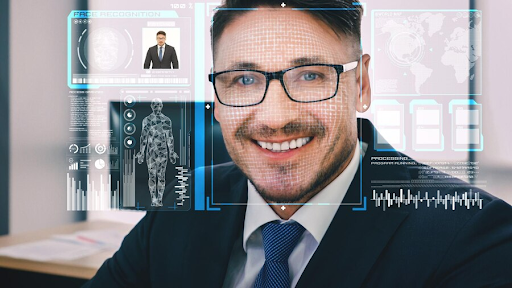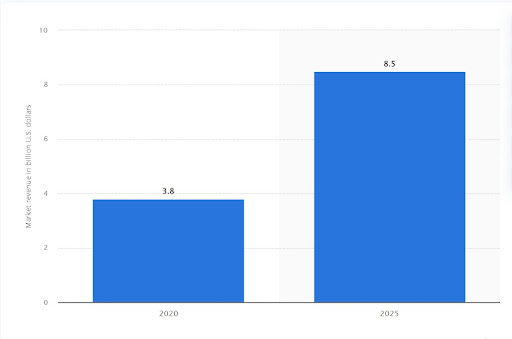Face Recognition With AI: How To Develop Smart Surveillance
Wondering how AI is transforming the smart surveillance industry? Learn how AI helps with different face recognition use cases and smart surveillance.
Join the DZone community and get the full member experience.
Join For Free Image Source: https://www.statista.com
Image Source: https://www.statista.com
Face recognition technology has been evolving and aiding the development of intelligent surveillance systems. These systems allow organizations to monitor a group of individuals or people for security purposes and have enhanced security for different purposes, including number locks, pattern locks, and fingerprint sensors.
Especially in modern smartphones, facial recognition technology has seen massive adoption. There are several different facial recognition algorithms based on Artificial Intelligence to identify people and provide details on expressions.
Every facial recognition system identifies a person’s facial features and converts them into a data matrix. These data matrices are stored in a database for analysis, data-driven business decisions, and improvements in security policy.

Image Source: https://www.statista.com
This is the reason why the facial recognition market has been increasing. Despite the pandemic, which affected different industries, the facial recognition market saw a revenue of $3.8 billion in 2020. It is further expected to reach $8.5 billion by 2025.
There is no denying that facial recognition systems are seeing a massive demand in different industries. However, organizations need advanced facial recognition systems to counter inaccuracies. Here, we will discuss how AI is transforming face recognition systems. Let’s start by understanding how facial recognition works.
Facial Recognition: How Does It Work?
Every facial recognition system works to capture, identify, and analyze the model. Further, it also needs a massive database of curated facial data for analysis and comparison. The process of facial recognition begins by capturing an image or video of the person by a camera.
It can be a CCTV camera, mobile phone camera, or others. Once the image is captured, facial recognition software will identify vital facial features like the distance between the forehead and chin, space between eyes, nose tip protrude, etc. There are 68 different facial landmarks that the software can identify.
Further, based on these landmarks, a facial recognition matrix is created. It is a mathematical formula that represents facial data. Finally, this data is compared with the already stored information of millions of people in the database. When it comes to the accuracy of facial recognition software, a study suggests 99.97% accuracy.
So, what’s AI got to do with it?
To understand the impact of AI on facial recognition and how it works, let’s discuss three essential stages of facial recognition.
Stages of Facial Recognition
Facial recognition is a three-stage process that includes detection, analysis, and recognition.
Detection
Detection is the process of scanning the captured facial images. Furthermore, this process involves facial mapping.
Analysis
The analysis is the second process that involves identifying facial landmarks, the distance between them, and generating metadata.
Recognition
An AI algorithm recognizes these data in the recognition process. The algorithm will sort the metadata from a large pool of databases. However, the function of AI is not just limited to matching the image metadata to the already existing one. The use cases of AI algorithms for smart surveillance are limitless.
Smart Surveillance Use Cases for AI
AI has been powering many use cases, from security purposes to authentication and even Natural Language Programming(NLP). Businesses and security authorities can customize these algorithms for specific use cases.
AI for Security
Face recognition can be used to help secure sensitive areas such as airports, government facilities, and corporate offices. Here, AI allows security authorities to identify passengers and enable the recognition of expressions. This allows security personnel to analyze the situation and human intent.
Take an example of the EES or Entry/Exit System developed by the European Union member states. It is an AI-based smart surveillance system that helps in tracking short-stay-visa holders across the EU’s external borders.
Similarly, many smart surveillance systems all over the world use AI for enhanced tracking. Another key use case for AI-based face recognition is user authentication.
User Authentication
In today's online world, it is increasingly common for users to need to provide authentication credentials such as their username and password to access certain websites or services. However, by using facial recognition technology, it is possible to quickly and easily verify a user's identity without having to enter any personal information.
For example, the National Australia bank partnered with Microsoft to develop an AI-based face recognition system that authenticates users to unlock ATMs. However, not just authentication but tracking objects or individuals is an important face recognition use case.
Tracking and Surveillance
Facial recognition can help track and monitor individuals or objects of interest. This can be used for a variety of purposes, such as security monitoring, fraud detection, and monitoring the whereabouts of children or pets.
The 2019 Brit Awards is one such example, where facial recognition powered by AI was used to track every entry for the event. In addition, it was linked to a mobile application, and the security personnel executed remote verification of event attendees.
Voice Recognition
As we continue to rely more and more on computers to interact with us, it becomes increasingly important to be able to process our interactions with computers naturally. For example, you can create user interfaces that are both intuitive with AI-based facial recognition and voice recognition.
For example, a new type of AI algorithm called Speech2Face has been developed at MIT that can build an image through voice recognition. It uses Convoluted Neural Networks(CNN) to convert the user’s voice into a spectrum.
Further, CNN also enables the creation of a spectrogram that gradually dictates every facial feature based on the audio profile. It is almost similar to smelling an orange or banana and dictating the pictographic drawing.
Conclusion
Facial recognition based on AI has many applications spanning different business domains. It is not restricted to security purposes and can help in enhancing the user experience if executed well. However, the integration of facial recognition technology into your business model and existing applications can be different from others.
Therefore, it becomes essential that you analyze your organizational goals, existing applications, system, and structure before implementing facial recognition. Such analysis also helps customize the AI algorithms that power facial recognition systems.
Opinions expressed by DZone contributors are their own.

Comments